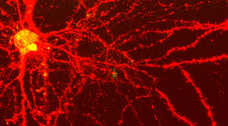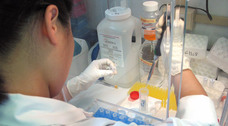
Four major themes cover the research activities in Rémi Quirion's laboratory.
The funding is mostly from the three CIHR grants and the additional support from the Alzheimer’s Society of Canada and some private firms.
1 – Functional organization of the cholinergic system and the possible significance of its dysfunction in aging and dementia of the Alzheimer’s type
Rémi Quirion's laboratory is interested to uncover links between key phenotypes (amyloids, tau protein and cholinergic losses) of the Alzheimer’s brain. Ongoing projects include the following studies:
1) The role of the muscarinic M2 autoreceptors in learning and memory focusing on its mechanism of action to reverse cognitive deficits in memory impaired animals (gene chip arrays, in vivo dialysis and behaviors). We are also investigating the potential trophic-neuroprotective abilities of nicotine and nicotinic receptors in aging.
2) The potential use of trophic factors, especially NGF and IGF-1 (and possibly certain chemokines), to inhibit neuronal loss and cholinergic dysfunction seen in aging and dementia. Current focus is on intracellular pathways (akt kinase, transcription factors) leading to these neuroprotective-neuromodulating activities (cell culture, molecular approaches and drug design).
3) The neuroprotective abilites (and mechanisms of action) of certain natural products and their potential usefulness in the treatment of dementia. Our current focus is on various polyphenols present in tea (catechins) and red wine (resveratrol). Our ultimate goal is to find new approaches for treating or preventing age-associated memory impairments.
4) The molecular changes occurring in the hippocampus in response to Alzheimer's disease linked mutations in amyloid precursor protein and Presenilins (proteomic approaches including one and two dimensional electrophoresis and mass spectrometry). We are particularly interested in proteomic changes occurring long before the onset of memory impairments and plaque formation.
We hope to identify molecular biomarkers for Alzheimer's disease that can be used for diagnosis as well as prediction of the disease.
2 – Understanding the role of the various neuropeptide Y (NPY) receptor sub-types in mediating the broad variety of central effects induced by this neuropeptide

NPY is among the most potent stimulant of food intake and inhibitor of sexual behaviors characterized thus far. Rémi Quirion's laboratory’s research on NPY aims to better characterize the unique molecular features of each one of the five NPY receptor sub-types using site-directed mutagenesis, in vitro bioassays, primary cell cultures etc. We are particularly interested to establish the respective internalization and recycling profile of each NPY receptor sub-type as well as the possible existence of homo/hetero dimers which could explain unique receptor profiles that failed to be cloned thus far. On a more functional level, we are focusing on the putative role of NPY and homologues in learning and memory paradigms, and mood behaviors with a special emphasis on the Y2 sub-type. Another recently characterized neuropeptide, nociceptin is studied for comparison. Our aim is to develop new therapies for CNS related diseases based on NPY receptor pharmacology.
3 – Understanding the mechanism of action and pharmacology of the calcitonin-gene related peptide (CGRP), and its role in pain
Early on, we were first to suggest the existence of multiple CGRP receptor sub-types. It is now established that the CGRP receptor sub-types classified as the CGRP1 receptor is unique among the rhodopsin GPCR family as it is composed of a seven-transmembrane protein known as CRLR plus a chaperone protein known as RAMP, by itself CRLR is non-functional and must be co-expressed along with RAMP1 to create an active CGRP receptor. In the presence of RAMP2, CRLR generates an adrenomedullin receptor, another member of the CGRP peptide family. However, the CGRP2 receptor sub-type that we proposed over 10 years ago still has to be cloned, as well as possibly others. A major aim of the present proposal is thus to clone these unique CGRP receptors using enriched cell lines and tissue preparations. Another objective of this project is to develop receptor sub-type selective agonists and antagonists (in collaboration with chemists) in order to better establish their respective role(s) in the organism. Functionally, we are studying the role of CGRP and adrenomedullin in pain and in tolerance to the antinociceptive action of opiates such as morphine. This project is based on our recent finding that a peptide antagonist, CGRP8-37, can block the development of tolerance to the analgesic action of morphine in acute pain models. The lab members now wish to establish if this antagonist is also effective in models of inflammatory and neuropathic pain. We are also investigating the role of CGRP and adrenomedullin in neuroimmune interaction, a novel mechanism involved in the underlying mechanisms of neuropathic pain and morphine tolerance. If successful, our project could lead to the development of a new adjunct therapy for the treatment of chronic pain.
4 – Studies on the so-called neurodevelopmental hypothesis of schizophrenia
Rémi Quirion's lab members hope that these studies will shed new light on the etiology of schizophrenia and related disorders. For this project, we have collaborated with Lalit Srivastava, PhD (Douglas Institute, McGill University) for almost a decade. The aim here is to develop new animal models of schizophrenia that take into account the purported neurodevelopmental features of the disease including its clinical manifestation following the onset of puberty.
One model involves bilateral ventral hippocampal lesions in neonatal animals to which we have added an early treatment with phencyclidine (PCP), a molecule known to induce psychotic-like behaviors in human. Currently we are interested to discover the key genes in particular that are regulated following such interventions (DNA microarrays, behaviors, etc.).
Based on the observation of altered protein expression at the level of the plasma membrane in the prefrontal cortex of schizophrenic patients, as well as the fact that the pharmacological targets of drug treatments for this disease are plasma membrane receptors such as dopamine D2 and glutamate receptors, we hypothesized that an altered protein expression and/or protein translocation to and from the plasma membrane in prefrontal cortical cells underlies this disease. Our lab has developed a novel proteomic approach that allows the study of alterations in protein expression in organelles such as the plasma membrane. The goal of this study is to obtain a better understanding of dysregulated protein expression in schizophrenia, to discover new drug targets and possibly to develop new animal models of this disease.
Contact information
Douglas Institute
Rémi Quirion's laboratory
6875 LaSalle Boulevard
Montréal, (Québec) H4H1R3
Phone: 514-762-3048
Fax: 514-762-3034
General Information: Please contact Rémi Quirion
Webmaster: mira_dot_thakur_At_douglas_dot_mcgill_dot_ca
Mira Thakur


